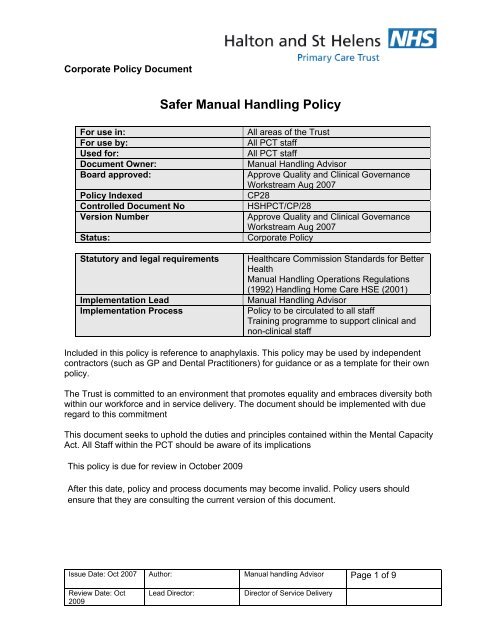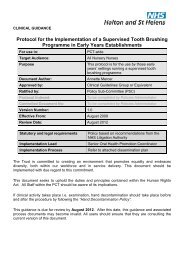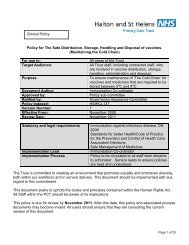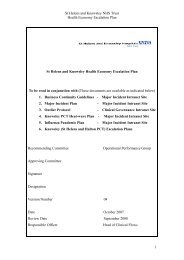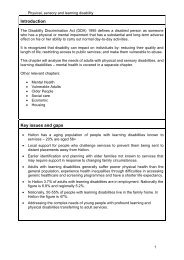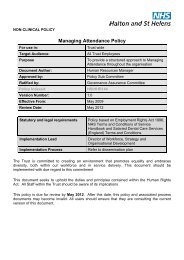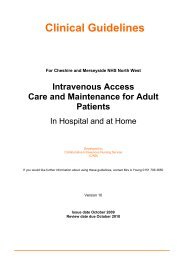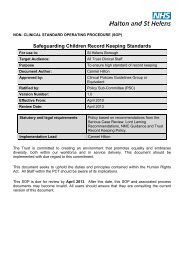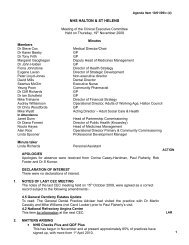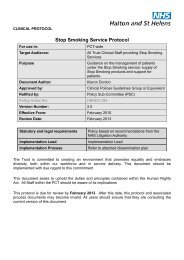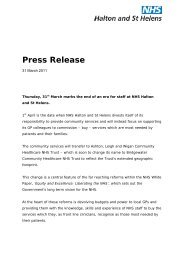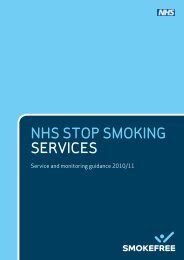Safer Manual Handling Policy - Halton and St Helens PCT
Safer Manual Handling Policy - Halton and St Helens PCT
Safer Manual Handling Policy - Halton and St Helens PCT
Create successful ePaper yourself
Turn your PDF publications into a flip-book with our unique Google optimized e-Paper software.
Corporate <strong>Policy</strong> Document<br />
<strong>Safer</strong> <strong>Manual</strong> <strong>H<strong>and</strong>ling</strong> <strong>Policy</strong><br />
For use in:<br />
For use by:<br />
Used for:<br />
Document Owner:<br />
Board approved:<br />
<strong>Policy</strong> Indexed<br />
Controlled Document No<br />
Version Number<br />
<strong>St</strong>atus:<br />
<strong>St</strong>atutory <strong>and</strong> legal requirements<br />
Implementation Lead<br />
Implementation Process<br />
All areas of the Trust<br />
All <strong>PCT</strong> staff<br />
All <strong>PCT</strong> staff<br />
<strong>Manual</strong> <strong>H<strong>and</strong>ling</strong> Advisor<br />
Approve Quality <strong>and</strong> Clinical Governance<br />
Workstream Aug 2007<br />
CP28<br />
HSH<strong>PCT</strong>/CP/28<br />
Approve Quality <strong>and</strong> Clinical Governance<br />
Workstream Aug 2007<br />
Corporate <strong>Policy</strong><br />
Healthcare Commission <strong>St</strong><strong>and</strong>ards for Better<br />
Health<br />
<strong>Manual</strong> <strong>H<strong>and</strong>ling</strong> Operations Regulations<br />
(1992) <strong>H<strong>and</strong>ling</strong> Home Care HSE (2001)<br />
<strong>Manual</strong> <strong>H<strong>and</strong>ling</strong> Advisor<br />
<strong>Policy</strong> to be circulated to all staff<br />
Training programme to support clinical <strong>and</strong><br />
non-clinical staff<br />
Included in this policy is reference to anaphylaxis. This policy may be used by independent<br />
contractors (such as GP <strong>and</strong> Dental Practitioners) for guidance or as a template for their own<br />
policy.<br />
The Trust is committed to an environment that promotes equality <strong>and</strong> embraces diversity both<br />
within our workforce <strong>and</strong> in service delivery. The document should be implemented with due<br />
regard to this commitment<br />
This document seeks to uphold the duties <strong>and</strong> principles contained within the Mental Capacity<br />
Act. All <strong>St</strong>aff within the <strong>PCT</strong> should be aware of its implications<br />
This policy is due for review in October 2009<br />
After this date, policy <strong>and</strong> process documents may become invalid. <strong>Policy</strong> users should<br />
ensure that they are consulting the current version of this document.<br />
Issue Date: Oct 2007 Author: <strong>Manual</strong> h<strong>and</strong>ling Advisor Page 1 of 9<br />
Review Date: Oct<br />
2009<br />
Lead Director:<br />
Director of Service Delivery
CONTENTS<br />
Page No<br />
1 Aims of <strong>Policy</strong> 3<br />
1.1 <strong>Policy</strong> <strong>St</strong>atement 3<br />
2 Managers <strong>and</strong> Employees 3<br />
3 Scope of the <strong>Policy</strong> 3<br />
4 Responsibility of Employer 3<br />
5 Risk Assessment – Organisational Arrangements 4<br />
5.1 Work Based <strong>Manual</strong> <strong>H<strong>and</strong>ling</strong> Risk Assessors/Instructors 4<br />
6 Responsibilities of Employees 4<br />
7 Operational Remedial Action 5<br />
8 M<strong>and</strong>atory Training 6<br />
9 Responsibility of <strong>Manual</strong> <strong>H<strong>and</strong>ling</strong> Advisor 6<br />
10 Responsibilities of Link Persons (People H<strong>and</strong>lers) 6<br />
11 Occupational Health 7<br />
12 Guidance for Clinical <strong>St</strong>aff – How to manage a patient 7<br />
who has fallen<br />
12.1 The Falling Patient 7<br />
12.2 The Uninjured Conscious Fallen Person 7<br />
13 Safe Systems of Work for Employees <strong>Manual</strong> <strong>H<strong>and</strong>ling</strong> 8<br />
of Loads<br />
14.1 Main steps to Correct Lifting 8<br />
14.2 General Information 8<br />
References 9<br />
Appendix 1 - Clinical <strong>St</strong>aff Training Needs<br />
Appendix 2 - Access to a Portable Hoist<br />
Appendix 3 - Process for Procurement of Emergency Hoist<br />
Appendix 4 – Procurement of Emergency Hoist in <strong>St</strong> <strong>Helens</strong><br />
in <strong>Halton</strong><br />
Issue Date: Oct 2007 Author: <strong>Manual</strong> h<strong>and</strong>ling Advisor Page 2 of 9<br />
Review Date: Oct<br />
2009<br />
Lead Director:<br />
Director of Service Delivery
1. AIMS OF POLICY<br />
This policy reflects the European Community Directive on the manual h<strong>and</strong>ling of loads as set<br />
out in:<br />
• The <strong>Manual</strong> <strong>H<strong>and</strong>ling</strong> Operations Regulation 1992<br />
• The Health <strong>and</strong> Safety at Work Act 1974<br />
• Management of Health <strong>and</strong> Safety at Work Regulations 1992<br />
• Workplace (Health, Safety & Welfare Regulations) 1992<br />
• The provision <strong>and</strong> use of Workplace Equipment Regulations 1998<br />
• The Lifting Operation <strong>and</strong> Lifting Equipment Regulations 1998<br />
1.1 <strong>Policy</strong> <strong>St</strong>atement<br />
<strong>Halton</strong> <strong>and</strong> <strong>St</strong>. <strong>Helens</strong> Primary Care Trust operate a <strong>Safer</strong> <strong>H<strong>and</strong>ling</strong> <strong>Policy</strong> in respect of patient<br />
h<strong>and</strong>ling i.e. no one should be lifting a patient’s full body weight. This policy aims to protect<br />
patients <strong>and</strong> staff against the risk of injury to any part of the body during moving <strong>and</strong> h<strong>and</strong>ling<br />
operations.<br />
<strong>Manual</strong> <strong>H<strong>and</strong>ling</strong> is defined as:<br />
Any transporting of a load by h<strong>and</strong> or bodily force.<br />
lowering or carrying.<br />
This includes pulling, pushing, lifting,<br />
A load is identified as:<br />
A moveable object e.g. a person or inanimate object. In exceptional circumstances e.g.<br />
emergency or life threatening situations, it is recognised that there is a need to move quickly<br />
without the proper equipment.<br />
2. MANAGERS AND EMPLOYEES<br />
Both managers <strong>and</strong> employees are responsible for complying with the requirements of this<br />
legislation, <strong>and</strong> subsequently of this policy.<br />
3. SCOPE OF THE POLICY<br />
This policy applies to all staff employed by, or working within <strong>Halton</strong> <strong>and</strong> <strong>St</strong>. <strong>Helens</strong> Primary<br />
Care Trust (hereafter referred to as the ‘Trust’) <strong>and</strong> covers all working environments.<br />
4. RESPONSIBILITY OF EMPLOYER<br />
The Trust recognises <strong>and</strong> accepts its responsibilities identified within the <strong>Manual</strong> <strong>H<strong>and</strong>ling</strong><br />
Operations Regulations (1992) <strong>and</strong> the Health <strong>and</strong> Safety at Work Act (1974). It will<br />
endeavour, so far as is reasonably practicable, to avoid the need for its employees to<br />
undertake any manual h<strong>and</strong>ling operations which involve a risk of them being injured.<br />
It will implement a risk assessment process that identifies the safest approach for moving <strong>and</strong><br />
h<strong>and</strong>ling people or objects.<br />
Managers are responsible for developing a safe system of work <strong>and</strong> ensuring compliance with<br />
those systems through information, instruction, supervision <strong>and</strong> training.<br />
Issue Date: Oct 2007 Author: <strong>Manual</strong> h<strong>and</strong>ling Advisor Page 3 of 9<br />
Review Date: Oct<br />
2009<br />
Lead Director:<br />
Director of Service Delivery
5. RISK ASSESSMENT – ORGANISATIONAL ARRANGEMENTS<br />
Service Managers should nominate staff to be trained as assessors. These staff will be<br />
trained by the <strong>Manual</strong> <strong>H<strong>and</strong>ling</strong> Advisor <strong>and</strong> must be given management support in order to<br />
carry out their duties. However, in respect of the district nursing service all nursing staff of<br />
staff nurse grade <strong>and</strong> above will be trained to undertake risk assessment in respect of<br />
h<strong>and</strong>ling patients.<br />
5.1 Work Based <strong>Manual</strong> <strong>H<strong>and</strong>ling</strong> Risk Assessors/Instructors<br />
• Carry out manual h<strong>and</strong>ling risk assessments <strong>and</strong> make appropriate<br />
recommendations, which avoids hazardous manual h<strong>and</strong>ling.<br />
• Give instruction to new staff during the induction period <strong>and</strong> ‘on the job’ training<br />
as required.<br />
• Train <strong>and</strong> coach staff in their own area.<br />
• Monitor <strong>and</strong> counsel staff in order to avoid hazardous manual h<strong>and</strong>ling.<br />
• Promote changes in practice which avoid manual h<strong>and</strong>ling risk.<br />
• Ensure that suitable training programmes exist.<br />
• Monitor manual h<strong>and</strong>ling techniques in the workplace.<br />
• Disseminate new h<strong>and</strong>ling techniques to all staff.<br />
• Offer general suggestions for improvements in manual h<strong>and</strong>ling practice to<br />
appropriate officers.<br />
• Assessors/instructors in patient areas should ensure condemned techniques<br />
are not used. Persistent use of these techniques in an area should be brought<br />
to the attention of the appropriate manager as a matter of urgency.<br />
• Assessors/instructors in non-patient areas should ensure unsafe techniques are<br />
not used.<br />
• Persistent poor h<strong>and</strong>ling should be brought to the appropriate manager’s<br />
attention.<br />
6. RESPONSIBILITIES OF EMPLOYEES<br />
• It is every employee’s responsibility to evaluate manual h<strong>and</strong>ling operations that<br />
occur during their work <strong>and</strong> to ensure the assessment remains valid. Every<br />
employee must take steps within their control to reduce risk of injury to<br />
themselves, patients, carers <strong>and</strong> other colleagues.<br />
• Should an employee feel that they are not able to execute a task without risk of<br />
injury, they should inform their line manager, who then has a duty to act on this<br />
information.<br />
Issue Date: Oct 2007 Author: <strong>Manual</strong> h<strong>and</strong>ling Advisor Page 4 of 9<br />
Review Date: Oct<br />
2009<br />
Lead Director:<br />
Director of Service Delivery
• Employees must observe/establish safe systems of work.<br />
• Employees must use equipment provided for manual h<strong>and</strong>ling operations <strong>and</strong><br />
reporting defects as appropriate.<br />
• Employees must participate in training.<br />
• Employees have a duty to alert their employer to any physical conditions, which<br />
might reasonably be considered to affect their ability to h<strong>and</strong>le loads safely<br />
• Employees have a duty to report all injuries <strong>and</strong> accidents to the Manager <strong>and</strong><br />
complete an incident report form as soon as possible after the event. Near<br />
misses should also be reported to the Manager to enable preventative action to<br />
be taken.<br />
• <strong>St</strong>aff in breach of any aspect of the <strong>Manual</strong> <strong>H<strong>and</strong>ling</strong> <strong>Policy</strong> may have<br />
disciplinary action against them.<br />
7. OPERATIONAL REMEDIAL ACTION<br />
In response to any employee’s concerns regarding manual h<strong>and</strong>ling operations, Service<br />
Managers have the direct day-to-day responsibility to provide immediate advice when possible<br />
<strong>and</strong> to undertake remedial action. They should seek advice from the <strong>Manual</strong> <strong>H<strong>and</strong>ling</strong> Advisor<br />
<strong>and</strong> Risk Manager as appropriate.<br />
If a risk assessment identifies hazardous techniques, a balanced decision making<br />
approach should be used ensuring that:<br />
• <strong>St</strong>aff are not required to perform tasks that put them <strong>and</strong> patients at risk<br />
unreasonably.<br />
• Patient’s personal wishes on mobility assistance are respected wherever<br />
possible.<br />
• Patient’s independence <strong>and</strong> autonomy is supported as fully as possible.<br />
The family should be informed of <strong>Manual</strong> <strong>H<strong>and</strong>ling</strong> Operations Regulation (1992) <strong>and</strong><br />
the legal requirements involved. The full implications of h<strong>and</strong>ling risk to all concerned<br />
should be discussed.<br />
Following consultation with patient <strong>and</strong> family, Service Managers in liaison with their<br />
Directors <strong>and</strong> the Risk Manager, will have the authority to withdraw aspects of the<br />
service if a safe system of work cannot be agreed on.<br />
In the case of a near miss, the Service Manager should provide written details to the Risk<br />
Manager together with recommendations for remedial action. An IRI form should be<br />
completed.<br />
NB Equipment supplied by the Trust will be delivered <strong>and</strong> assembled on the ground floor of<br />
homes (with the exception of flats). The assessing health care professional should make this<br />
clear to relatives prior to requesting equipment.<br />
Issue Date: Oct 2007 Author: <strong>Manual</strong> h<strong>and</strong>ling Advisor Page 5 of 9<br />
Review Date: Oct<br />
2009<br />
Lead Director:<br />
Director of Service Delivery
8. MANDATORY TRAINING<br />
Training is m<strong>and</strong>atory for all staff non-clinical <strong>and</strong> clinical. Non-clinical staff will be offered<br />
training on induction <strong>and</strong> every 3 years. This will give staff an awareness of the legislation <strong>and</strong><br />
its application <strong>and</strong> an underst<strong>and</strong>ing of ergonomics <strong>and</strong> the safe lifting of inanimate loads.<br />
All clinical staff will receive training from the <strong>Manual</strong> <strong>H<strong>and</strong>ling</strong> Advisor <strong>and</strong> the training will be<br />
in a modular form. All staff will access the first 2 modules <strong>and</strong> the further modules will be for<br />
staff who h<strong>and</strong>le patients. A competency assessment booklet will accompany all training to<br />
ensure staff have evidence of their competency level. See Appendix 1 for further details of<br />
training required for different staff groups.<br />
Additional training in the workplace for specific staff groups can be arranged with the <strong>Manual</strong><br />
<strong>H<strong>and</strong>ling</strong> Advisor.<br />
9. RESPONSIBILITY OF MANUAL HANDLING ADVISOR<br />
Will have the nominated day-to-day responsibility for ensuring the provision of up-to-date<br />
professional advice on manual h<strong>and</strong>ling matters, monitoring the implementation of the policy<br />
<strong>and</strong> identifying areas of actual or potential concern.<br />
The <strong>Manual</strong> <strong>H<strong>and</strong>ling</strong> Advisor will develop <strong>and</strong> provide a comprehensive training programme<br />
for all grades of staff, tailored to the requirements of specific groups.<br />
The <strong>Manual</strong> <strong>H<strong>and</strong>ling</strong> Advisor will develop <strong>and</strong> maintain effective networks <strong>and</strong> relationships<br />
with link persons in the Trust, <strong>and</strong> key agencies outside in order to allow the safer lifting policy<br />
to be effective <strong>and</strong> to influence best practice in the workplace.<br />
10. RESPONSIBILITIES OF LINK PERSONS (PEOPLE HANDLERS)<br />
The link person (nurse, occupational therapist or physiotherapist) will be supported by the<br />
<strong>Manual</strong> h<strong>and</strong>ling advisor at Link Group Meetings so they can provide the following at each<br />
base:<br />
• Theoretical aspects of training in moving <strong>and</strong> h<strong>and</strong>ling where required.<br />
• Updating the moving <strong>and</strong> h<strong>and</strong>ling manual <strong>and</strong> ensuring all staff are aware of<br />
new supplements.<br />
• Practical demonstrations of techniques for individual patients, in conjunction<br />
with moving/h<strong>and</strong>ling advisor where appropriate.<br />
• Liaise any areas of concern from team members at link meetings.<br />
<strong>St</strong>udents or Temporary <strong>St</strong>aff<br />
• Must be shown how to h<strong>and</strong>le patients/equipment on an individual basis by the<br />
trained nurse involved.<br />
Issue Date: Oct 2007 Author: <strong>Manual</strong> h<strong>and</strong>ling Advisor Page 6 of 9<br />
Review Date: Oct<br />
2009<br />
Lead Director:<br />
Director of Service Delivery
11. OCCUPATIONAL HEALTH<br />
<strong>St</strong>aff recruitment <strong>and</strong> selection procedures are designed to identify potential employees who<br />
would be at risk from manual h<strong>and</strong>ling injury. Pre-employment screening is therefore<br />
essential.<br />
<strong>St</strong>aff suffering a muscular skeletal injury or significant back problem will be offered support by<br />
the Occupational Health Department.<br />
12. GUIDANCE FOR DISTRICT NURSES – HOW TO MANAGE A PATIENT WHO HAS<br />
FALLEN<br />
12.1 The Falling Patient<br />
If the patient is collapsing <strong>and</strong> cannot be persuaded to st<strong>and</strong>, he must be lowered to the<br />
ground immediately.<br />
Health Care Professionals to execute the following moves. She/He:<br />
• Releases her/his hold of the patient<br />
• Moves behind the patient<br />
• Opens her/his h<strong>and</strong>s <strong>and</strong> takes one step back<br />
• Allows the patient to slide to the floor<br />
• Lets the patient remain in a sitting position on the floor<br />
• If the patient has fainted, then the health care professional can kneel <strong>and</strong> allow<br />
the patient to lie down. He/She then repositions himself/herself to place patient<br />
in the recovery position<br />
Source:<br />
‘The Guide to the <strong>H<strong>and</strong>ling</strong> Of Patients 5 th Edition<br />
Assessment<br />
Make the area safe. Assess the patient for injury. If the patient is unconscious or injured call<br />
the Ambulance Service on 999.<br />
12.2 The Uninjured Conscious Fallen Person<br />
This technique is useful to teach people who live alone <strong>and</strong> who regularly fall. It provides<br />
reassurance to them that they can get up by themselves <strong>and</strong> do not always have to wait for<br />
help to arrive.<br />
• <strong>St</strong>ay calm <strong>and</strong> remain with the person, do not let them hurry to get up.<br />
• Place a pillow under the person’s head <strong>and</strong> wait until they feel ready to try to<br />
get up. If necessary sit on the floor next to him <strong>and</strong> reassure them until they<br />
feel less disorientated.<br />
• Encourage the person to bend up both knees (one at a time) <strong>and</strong> roll onto their<br />
side, <strong>and</strong> press down with their lower elbow <strong>and</strong> upper h<strong>and</strong> to raise onto all<br />
fours.<br />
• Lean on the chair using both h<strong>and</strong>s.<br />
• Instruct the person to raise one leg <strong>and</strong> place one foot on the floor.<br />
• Push up to straighten legs <strong>and</strong> turn to sit onto the chair.<br />
Issue Date: Oct 2007 Author: <strong>Manual</strong> h<strong>and</strong>ling Advisor Page 7 of 9<br />
Review Date: Oct<br />
2009<br />
Lead Director:<br />
Director of Service Delivery
If the patient is unable to use this technique a hoist should be used. <strong>St</strong>aff must never<br />
manually lift a fallen patient from the floor except in a life threatening emergency, i.e. bomb,<br />
bullet, fire or flood.<br />
13. SAFE SYSTEM OF WORK FOR EMPLOYEES<br />
MANUAL HANDLING OF LOADS<br />
It is essential that the following procedures are followed when undertaking any manual<br />
h<strong>and</strong>ling exercise.<br />
Thirty three per cent of accidents are caused as a result of manual h<strong>and</strong>ling operations.<br />
These include transporting or supporting of a load or person (including the lifting, putting down,<br />
pushing, pulling, carrying or moving thereof) by h<strong>and</strong> or bodily force.<br />
The <strong>Manual</strong> <strong>H<strong>and</strong>ling</strong> Operations Regulations 1992 aim to reduce injury by avoiding h<strong>and</strong>ling<br />
tasks via mechanisation or by using the steps shown below:<br />
14.1 Main <strong>St</strong>eps to Correct Lifting<br />
1. Keep feet shoulder width apart, one foot ahead of the other in the direction of<br />
the intended movement.<br />
2. Keep the knees bent but not squat, the most effective power is gained by using the<br />
thigh muscles.<br />
3. Keep the arms close to the body as near as the centre of gravity as possible.<br />
4. Use the fingers <strong>and</strong> the palm of the h<strong>and</strong> to lift, rather than the tips of fingers.<br />
5. To avoid curving the spine, keep the chin out <strong>and</strong> up.<br />
14.2 General Information<br />
Take care when working above head height, even with “light” loads.<br />
Adopt a good base position when lifting, especially if moving objects from group level. Do not<br />
use your chair.<br />
Assess the weight of unknown objects before attempting to lift. Do not attempt to lift anything<br />
outside your capabilities. Seek assistance from other employees.<br />
If possible balance objects either side of the body when carrying.<br />
Where possible, split loads e.g. a box of A3 photocopying paper is 30kg. The box must be<br />
opened <strong>and</strong> packs lifted individually or two people must lift the box together.<br />
Only use identified moving aids to move equipment.<br />
Issue Date: Oct 2007 Author: <strong>Manual</strong> h<strong>and</strong>ling Advisor Page 8 of 9<br />
Review Date: Oct<br />
2009<br />
Lead Director:<br />
Director of Service Delivery
<strong>Manual</strong> <strong>H<strong>and</strong>ling</strong> Operations Regulations 1992<br />
References<br />
The Code to the <strong>H<strong>and</strong>ling</strong> of Patients 5 th Edition published by National Back Pain Association<br />
in collaboration with Royal College of Nursing 2005<br />
‘<strong>Safer</strong> <strong>H<strong>and</strong>ling</strong> of People in the Community’ produced by BackCare 1999<br />
<strong>H<strong>and</strong>ling</strong> Home Care published by HSE 2001<br />
Issue Date: Oct 2007 Author: <strong>Manual</strong> h<strong>and</strong>ling Advisor Page 9 of 9<br />
Review Date: Oct<br />
2009<br />
Lead Director:<br />
Director of Service Delivery
Appendix 1<br />
Clinical <strong>St</strong>aff Training Needs<br />
Passport Modules<br />
Update<br />
Required 1 2 3 4 5 6<br />
<strong>St</strong>aff Group<br />
(Years)<br />
Dental 3 *<br />
Podiatry 3 *<br />
District Nursing Annually <br />
Health Visiting 3 <br />
Midwifery 3 <br />
Sexual Health 3 <br />
School Nurses 3 <br />
Walk-in/Access Centres 3 <br />
Community Matrons 3 <br />
Specialist Nurses (i.e. Heart<br />
3 <br />
Failure, Macmillans, TV, CCN)<br />
OTs Annually <br />
Physios Annually <br />
Special School Nurses Annually <br />
Speech <strong>and</strong> Language 3 <br />
Out of Hours 3 <br />
Practice Nurses 3 *<br />
Social Care Annually <br />
Paediatric Carers Annually <br />
* Falling patient only<br />
All staff to access modules identified above. Existing staff must ensure they have<br />
completed the modules identified in their service every 3 years.<br />
<strong>St</strong>aff who move patients i.e. OTs, Physios <strong>and</strong> Community Nurses must have an<br />
annual update <strong>and</strong> this can take the form of a competency assessment.<br />
Module 1 = Theory<br />
Module 2 = Object <strong>H<strong>and</strong>ling</strong><br />
Module 3 = Bed Techniques<br />
Module 4 = Sit to <strong>St</strong><strong>and</strong><br />
Module 5 = Hoists<br />
Module 6 = Risk Assessments
Appendix 2<br />
ACCESS TO A PORTABLE HOIST.<br />
GUIDANCE FOR THE USE OF EMERGENCY HOIST (for <strong>Halton</strong> Patients only)<br />
• The hoist should only be used by staff that are trained in the assembly <strong>and</strong><br />
use of the hoist.<br />
• The hoist has a weight limit of 19 stone <strong>and</strong> is for emergency use only e.g.<br />
the fallen patient who has been assessed by a health care professional <strong>and</strong><br />
has no apparent injuries.<br />
• The patient with unpredictable weight bearing capacity (off-legs syndrome):<br />
• In an emergency where a patient’s own hoist may be out of action:<br />
THE AMBULANCE SERVICE SHOULD BE CONTACTED ON 999 IF THE PATIENT<br />
IS UNCONSCIOUS OR INJURED<br />
The hoists for <strong>Halton</strong> are located at:<br />
<strong>Halton</strong> Haven, Runcorn (01928 712728)<br />
Health Care Resource Centre, Widnes (Dental Dept F 02 0151 495 5000)<br />
1. Reception staff at either location should be informed that a taxi will be collecting<br />
the hoist.<br />
2. Grosvenor Taxis 01928 577777 should be contacted (stating NHS contract) <strong>and</strong><br />
the hoist will be delivered to the requested address.<br />
3. <strong>St</strong>aff should complete the drivers receipt book (which is kept in the bag). He will<br />
retain the blue copy. Yellow copy to be sent to Finance.<br />
4. If the hoist breaks down out of hours, the carers should contact the District<br />
Nursing Out of Hours who are responsible for ensuring that the carers using the<br />
hoist are trained <strong>and</strong> competent in its use. <strong>Halton</strong> Equipment Service (01928<br />
582922) should be informed ASAP to arrange for Trust drivers to collect the<br />
hoist after use.<br />
See Appendix 2 showing flowchart for process of procurement of emergency<br />
hoist.
Appendix 3<br />
Process for Procurement of Emergency Hoist in <strong>Halton</strong><br />
Hoist breaks down<br />
Leads/connections <strong>and</strong> power supply<br />
checked.<br />
Patient/carer contacts Independent Living Centre, Runcorn<br />
(01928 582920)<br />
Out of hours<br />
Working Hours (9am-5pm)<br />
9-5pm weekends/<br />
bank holidays<br />
5pm-9am<br />
Answer machine message will tell<br />
them to contact evenings <strong>and</strong><br />
nights District Nursing service<br />
Admin staff will ascertain fault <strong>and</strong><br />
provide replacement hoist if necessary or<br />
replacement part i.e. battery or<br />
contact engineer for repair (non urgent)<br />
Nursing service arrange for delivery of emergency<br />
hoist (kept at <strong>Halton</strong> Haven or HCRC)<br />
Nursing team instruct carers on use of<br />
hoist <strong>and</strong> ensure patient is safe<br />
Nursing team inform HICES of emergency<br />
<strong>and</strong> need to contact engineer<br />
HICES contact engineer to repair hoist<br />
HICES arrange collection/<br />
decontamination of emergency hoist <strong>and</strong><br />
provide replacement hoist from stock<br />
Engineer provides report regarding break<br />
down <strong>and</strong> HICES takes appropriate action
Appendix 4<br />
Procurement Of Emergency Hoist Equipment In <strong>St</strong> <strong>Helens</strong><br />
In case of Hoist Breakdown<br />
During working hours contact Knowsley <strong>St</strong>ores on 0151 289 6668<br />
After 4.30pm the Maintainance Engineer should be contacted on 07768 718305<br />
If Equipment is required at weekends<br />
The on call driver should be contacted on 07798 668773 between 8.30am <strong>and</strong> 4.30<br />
pm Saturday <strong>and</strong> Sunday.


